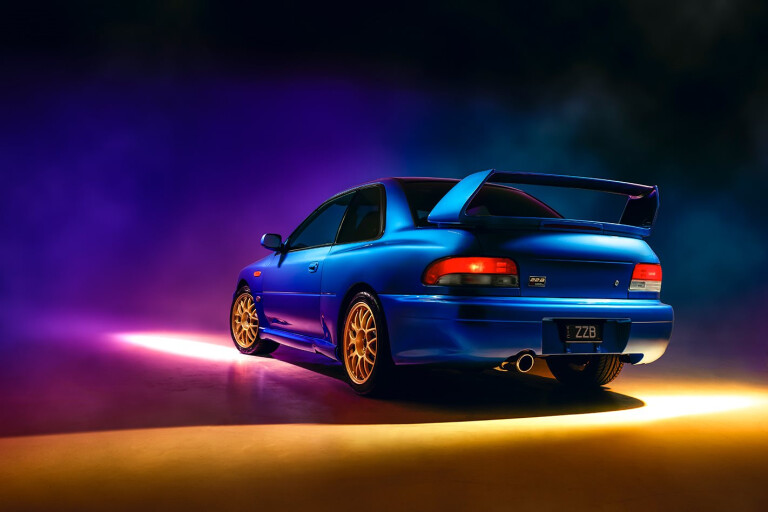
The Subaru Impreza peaked early. The nameplate enjoys a 28-year heritage, but reached its zenith a mere six years into its life cycle with the iconic WRX STi 22B.
Subaru has built quicker models since but none has ever been so perfectly redolent of a moment as this slice of box-arch exotica. A celebration of the company’s third rally world championship in a row, the 22B was, by any conventional product planning logic, a bit of a self-indulgence, with a production run that extended to a mere 400 official cars. There was a longstanding myth that there was no unlucky #13, but that car is owned by Subaru America.
All 22Bs were built between March and April 1998. When Subaru opened the taps on orders, they didn’t stay open long. Within hours, the entire allocation was spoken for. To give you an idea of how badly people wanted the cars, the UK received a quota of 16 cars, and by the time Prodrive had converted the speedometers to miles per hour, fitted a taller final-drive ratio and revised the headlights, 50 22Bs had been grey-imported from Japan. Australia received five cars, one of which was retained by the importer.
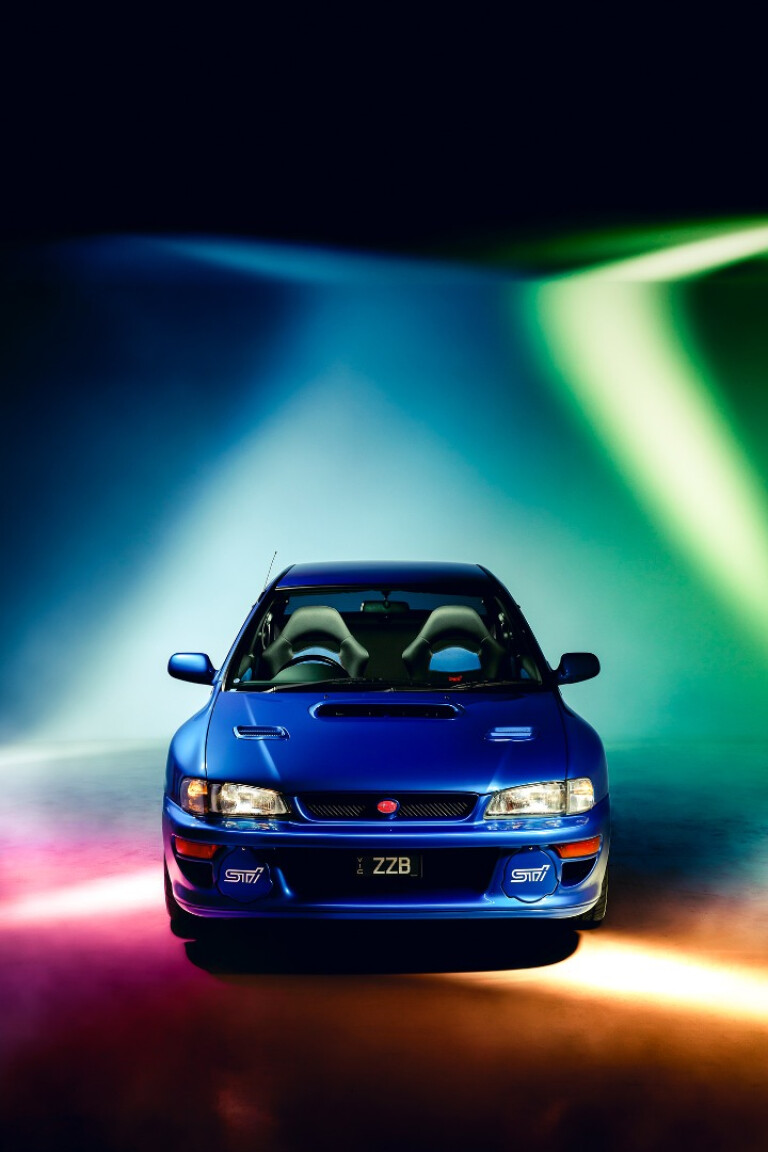
They were also eye-wateringly expensive. Back in 1998, they were put on sale at $125,000 apiece. Then Subaru insisted the buyer pay the $7000 certification cost for the 22B on top. The profit from the sale of those four cars was almost enough to buy the fifth car that Subaru Australia effectively gifted itself. Bear in mind that a Subaru WRX was a $40K car back then, so here was a limited-run special edition costing better than three times the price. Given that Nissan has tried to sell us a $1.4m GT-R50 by Italdesign special last year, Subaru was clearly ahead of the curve on premium-priced, limited-run editions.
Australian-market cars were undeniably expensive in 1993, and the 22B was still nine grand cheaper than a BMW E36 M3 Evo and a long way short of the $183K Porsche wanted for an entry-level 996 Carrera. Those that took the plunge would have been rewarded with a vehicle that was quicker, rarer, and which would hold its value far better than either of the German blue-bloods. Today, a clean 22B will change hands at upwards of $200,000; more if it has an interesting history.
Many do. Colin McRae was one of the lucky batch of owners but any expectation that he would be given a 22B for winning the World Rally Championship was soon disabused when Subaru sent him an invoice. Yes, he got a modest reduction, but he still had to buy the car. “I got a good price, but that really hurt, being Scottish!” he was quoted at the time.
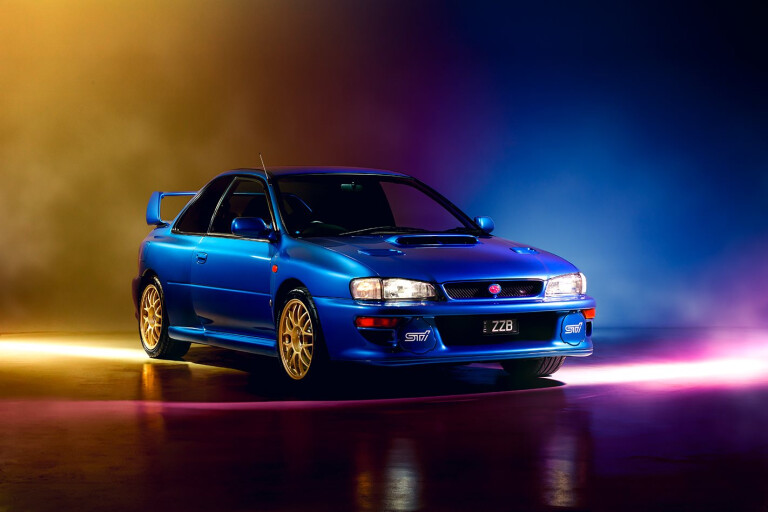
Contrary to popular belief, the 22B was never a homologation vehicle. It looks for all the world as if it is, with its aggressive box arches and enlarged 2.2-litre engine, but it was more of a celebration, a loose homage to the actual Peter Stevens-designed WRC ’97 rally car.
It was based on the existing two-door STI Version IV Type R, a car which retailed on the Japanese market for ¥3m, with the production run capped at 399. That’s not altogether true as there were a number of additional 000-numbered prototypes, three of which went to McRae, his co-driver Nicky Grist, and the boss of Prodrive, David Lapworth. One of these 000 cars sold in 2017 for $210,000 and an even better, low- mileage 000 car is for sale at Contempo Concept in Hong Kong with a rumoured asking price north of $400,000.
That price doesn’t get you a lot of things. It doesn’t net you foglights, just blue plastic blanking plates. You’ll search in vain for any airbags and a good stomp on the middle pedal reveals that there’s no anti-lock braking tech whatsoever. There’s not even a radio. What you do get is a small roller switch next to the handbrake that alters the torque split front to rear. This varies between 36 percent front and 64 percent rear to an even, Quattro-style 50/50 split whereupon the centre diff locks for maximum grip. You won’t use this on the road because locking the diff delivers industrial quantities of understeer that will shave the shoulders clean off the front 235/409ZR17 Pirelli P-Zeros.

The blistered arches were a rallying trope of the day, inspired by the likes of Audi’s Ur Quattro and Lancia’s Delta Integrale. Adding 80mm to the overall width of the 22B, the Coke-bottle flanks were emphasised by the overhead telephoto press shots of the day which compressed the car into a voluptuous caricature, wholly removed from its proletarian, narrow-arched Impreza siblings. Custom front and rear valances, gold BBS RG334 alloys, a pair of bonnet vents and a manually adjustable wing delivered the requisite special-stage émigré look.
It was far from just a cosmetic treatment, though. The engine was bored out to 2212cc from the standard 1994cc swept capacity and was designated EJ22 rather than EJ20 as a consequence. Forged pistons, an intercooler spray, shorter gearing from the Type RA, heavier duty drive and prop shafts and a ceramic-faced twin-plate clutch spoke of an attention to detail that went some way to justifying that price tag.
The official power figure conformed to the so-called ‘gentleman’s agreement’, namely that no Japanese performance cars would exceed 280PS (206kW), a uniform peak power figure shared by many Skyline GT-Rs, Supras, NSXs, RX-7s, Lancer Evos and Mitsubishi 3000 GTs of the era. You’ll read any number of commentators claiming that the 22B made way more power than this, but when Wheels strapped one to a dyno back in 2000, we saw 142kW at the hubs. What’s more, the performance figures of 0-100km/h in 4.7s and 0-400m in 13.8s were entirely consistent with an all-wheel-drive, 206kW car that weighs 1270kg. A generation later, those are much the same figures you’d get from an early Mk7 Golf R. Heavier car, better tyres, same result.
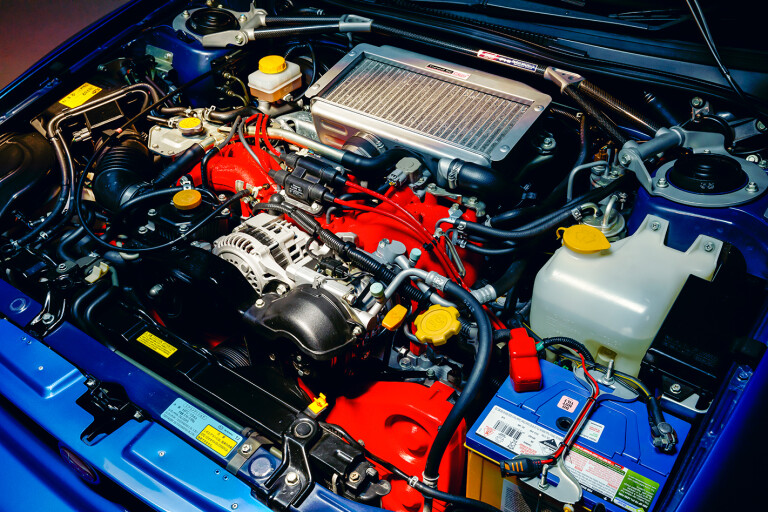
What was different about the 22B’s lump was its power delivery. It felt different to the hyperactive 2.0-litre EJ20 units, and possessed a broader swathe of torque, which deviated only a few Newton metres from its 353Nm peak all the way between 2750rpm and 5200rpm. The EJ22 had a nominal 7900rpm redline, but you never needed to wring it out.
Bob Hall was our man in the driver’s seat back in 2000 and while he noted that the numbers against the clock didn’t differ much to the 1999 STi Coupe, the experience seemed different. “What the numbers don’t relay is the 22B’s intensity. It’s almost violent,” he said. “If you don’t get a rush when the hammer’s dropped in this car, you should visit your local mortuary. Now.”
Hall loved the flexibility of the engine and its muscularity without too much in the way of turbo lag. “Passing speeds are a good indicator of day-to-day liveability and here the blister-guarded 22B shines,” he noted. “Leave it in fourth gear and getting from 80 to 100km/h to pass the pensioner will take a mere 2.9 seconds. In fifth, the little Subie shoots from 100km/h to 130km/h in 4.4 seconds.”

Some contemporary frame of reference? “While the standing start times are pretty much line-ball with the HSV GTS 300’s, the Subaru runs away from the Commodore in passing speeds. Purely for comparative purposes, the GTS 300 takes 4.3 seconds from 80 to 100km/h and 6.2 seconds from 100 to 130km/h. So who said you can’t beat cubic inches?”
While Hall wasn’t impressed by the baulky gearshift, or the adjustable torque split, which he dismissed as a gimmick for road use, he also noted the 22B’s punishing ride. That and some genuinely focused suspension which featured unique forged aluminium lower links, rose-jointed transverse links, upside-down Bilstein dampers and bespoke Eibach springs. “When it comes to chassis competence, we’ve been favourably impressed by previous STis, so there were high expectations for the 22B,” said Hall. “Still, nobody who drove it was quite ready for its adhesion and cornering competence.”
The quicker steering, low gearing, all-wheel-drive punch and beefier brakes combine to devastating effect when punting the 22B through tight corners. Big, open roads aren’t its forte, but diving towards a tight apex on the 294mm front discs, switching quickly to throttle and feeling the car transition subtly to its outside rear Pirelli, the thin-rimmed Nardi steering wheel letting you know how much traction the fronts are transmitting, is something truly joyous.

This might be more than two decades old, but the performance and the dynamics don’t feel particularly dated. The refinement and interior quality do, but in some regards it’s better than many moderns. Visibility for one. Then there’s the focus that you put on driving rather than encountering ‘mode anxiety’ as you do in so many new cars with a cornucopia of drive modes. Then there’s the fact that your right boot is connected to the throttle via a cable rather than through the filter of thousands of lines of code, and the same goes for the hydraulically assisted steering. There’s an immediacy to the 22B’s feedback loops that feels shockingly urgent.
The sound effects are from another era too. From the clattering frameless glass to the savage, guttural bark of the engine and the reptilian hissing of the turbocharger, it’s undeniably raw. The seat creaks, the induction system sucks great drafts of air and the tyres set up a resonant frequency that drenches the cabin. It might only be as quick as a Golf R but even at six tenths it’s one heck of an event. The ultimate Impreza is a big billing and the 22B could have fallen flat in the face of two decades of progress. That it doesn’t merely underscores its status. The 22B is the lineal champ that’s never stopped punching.

22B or P1?
On paper, the 22B lines up very closely to the Prodrive-developed two-door P1. Developed for the UK market, the P1 is, like the 22B, an impressive cross-country weapon, but at the time Subaru couldn’t make the DCCD centre diff work with ABS. The P1 ditched the diff and got anti-lock brakes instead. While it’s not as collectible or charismatic as the 22B, with values a whole lot lower, it might just make a better road car.
B thy Name
The 22B designation is perfect prosaic Subaru, the 22 referring to the 2.2-litre capacity and the B signifying the car’s Bilstein suspension. It’s mere coincidence that 22B is 555 in hexadecimal, coffin-nail manufacturer State Express 555 being one of Subaru’s major sponsors in world rallying.
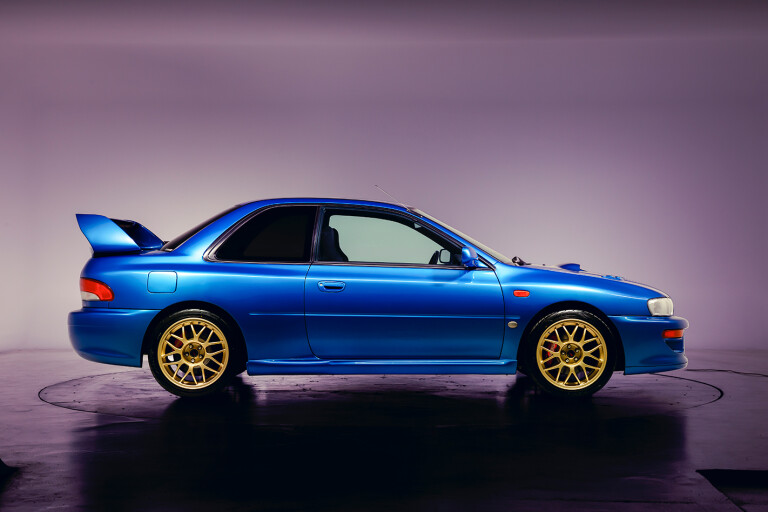
Who owns one? – Ian R, Melbourne
“This car came from Perth, and was once owned by the president of the WRX car club over there. It originally came into Sydney as a personal import back in 2007. There can’t be many in the world that are much better. I’ve been to the plant in Japan and seen the original car and they don’t look any different. I’m just about to sell it, I think. I don’t like a car that sits in the shed and you just admire it. To drive, it’s got real feel compared to cars of today. The steering feels alive. I drove a Ferrari 488. This is a nicer car to drive. I’d listen to an offer of somewhere over $200K for it.”
The good: Exclusivity; still feels an event to drive; great steering; mechanical toughness; tremendous visibility; McRae and Burns owned one
The bad: Rarity; some materials insubstantial; lateral grip no longer near the top tier; unyielding ride; now too valuable to drive it as intended
SPECS
ModelSubaru Impreza 22B-STi Version
Engine2212cc inline-four, dohc, turbo, 16v
Max power206kW @ 6000rpm
Max torque360Nm @ 3200rpm
Transmission5-speed manual
Weight1270kg
0-100km/h4.7sec
Price$125,000 (1998)



COMMENTS